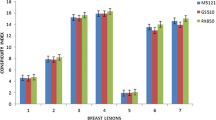Abstract
Our purpose in this study was to examine the potential usefulness of liquid–crystal display (LCD) monitors having the capability of rendering higher than 8 bits in display-bit depth. An LCD monitor having the capability of rendering 8, 10, and 12 bits was used. It was calibrated to the grayscale standard display function with a maximum luminance of 450 cd/m2 and a minimum of 0.75 cd/m2. For examining the grayscale resolution reported by ten observers, various simple test patterns having two different combinations of luminance in 8, 10, and 12 bits were randomly displayed on the LCD monitor. These patterns were placed on different uniform background luminance levels, such as 0, 50, and 100%, for maximum luminance. All observers participating in this study distinguished a smaller difference in luminance than one gray level in 8 bits irrespective of background luminance levels. As a result of the adaptation processes of the human visual system, observers distinguished a smaller difference in luminance as the luminance level of the test pattern was closer to the background. The smallest difference in luminance that observers distinguished was four gray levels in 12 bits, i.e., one gray level in 10 bits. Considering the results obtained by use of simple test patterns, medical images should ideally be displayed on LCD monitors having 10 bits or greater so that low-contrast objects with small differences in luminance can be detected and for providing a smooth gradation of grayscale.






Similar content being viewed by others
References
AAPM on-line report no.03, assessment of display performance for medical imaging systems, http://deckard.mc.duke.edu/~samei/tg18_files/tg18.pdf.
JESRA X-0093−2005 quality assurance (QA) guideline for medical imaging display systems. Japan Industries Association of Radiological Systems. Tokyo, Japan; 2005 http://www.jira-net.or.jp/e/index.htm.
Guideline for handling digital images 2.0 version, Japan Radiological Society, http://www.radiology.jp.
Digital Imaging and Communications in Medicine (DICOM) Part 14: Grayscale Standard Display Function PS 3.1-2007, http://medical.nema.org.
Kimura N, Fujioka K. Fundamentals of liquid crystal displays and its recent technology. Jpn J Rad Tech. 2004;60(10):1361–8 (in Japanese).
Hashimoto N. Image display devices (1). Jpn J Rad Tech. 2002;58(10):1297–302 (in Japanese).
Hashimoto N. Image display devices (3) LCD monitor. Jpn J Rad Tech. 2003;59(1):21–8 (in Japanese).
The Illuminating Engineering Institute of Japan. Lighting handbook. Tokyo: Ohmsha; 2006. p. 17–36 (in Japanese).
Flynn MJ. Visual requirements for high-fidelity display, advances in digital radiography: RSNA categorical course in diagnostic radiology physics 2003; 103–7.
Flynn MJ, Kanicki J, Badano A, Eyler WR. High fidelity electronic display of digital radiographs. Radiographics. 1999;19:1653–69.
Samei E. AAPM/RSNA Physics tutorial for residents technological and psychophysical considerations for digital mammographic d[t]isplays. Radiographics. 2005;25:491–501.
Giger ML, Ohara K, Doi K. Investigation of basic imaging properties in digital radiography 9. Effect of displayed grey levels on signal detection. Med Phys. 1986;13:312–8.
Giger ML, Ohara K, Doi K. Effect of quantization on digitized noise and detection of low-contrast objects. Proc Soc Photo Opt Instrum Eng. 1986;626:214–24.
Lane EJ, Proto AV, Phillips TW. Mach bands and density perception. Radiology. 1976;121:9–17.
Acknowledgments
The authors thank Noriyuki Hashimoto and Shigehisa Ogawa, Nanao Corporation, Fukuoka, Japan, and Kiyoshi Dogomori, Department of Radiology, Saga University Hospital, Saga, Japan, for helpful discussions and Eiji Sato, PSP Corporation, Tokyo, Japan, for providing image-viewing software. The authors are grateful to Hidetaka Arimura, Ph.D., and Seiji Kumazawa, Ph.D., Department of Health Sciences, Faculty of Medicine, Kyushu University, for useful suggestions and discussions; and to Ayumu Oishi, BS, Junya Ogushi, BS, Yasuo Kawata, BS, Daisuke Yamamoto, BS, Nobukazu Tanaka, BS, and Kentaro Naka, BS, Department of Health Sciences, Graduate School of Medical Sciences, Kyushu University, and Masaki Sueoka, BS, Foundation for Biomedical Research and Innovation, for participating in this study as observers. We are grateful to the editorial assistant of this journal for providing initial polishing of the submitted manuscript in improving the readability and English expressions, and the editors and reviewers for giving us useful comments and suggestions for improving our manuscript.
Author information
Authors and Affiliations
Corresponding author
About this article
Cite this article
Hiwasa, T., Morishita, J., Hatanaka, S. et al. Need for liquid–crystal display monitors having the capability of rendering higher than 8 bits in display-bit depth. Radiol Phys Technol 2, 104–111 (2009). https://doi.org/10.1007/s12194-008-0051-0
Received:
Revised:
Accepted:
Published:
Issue Date:
DOI: https://doi.org/10.1007/s12194-008-0051-0




